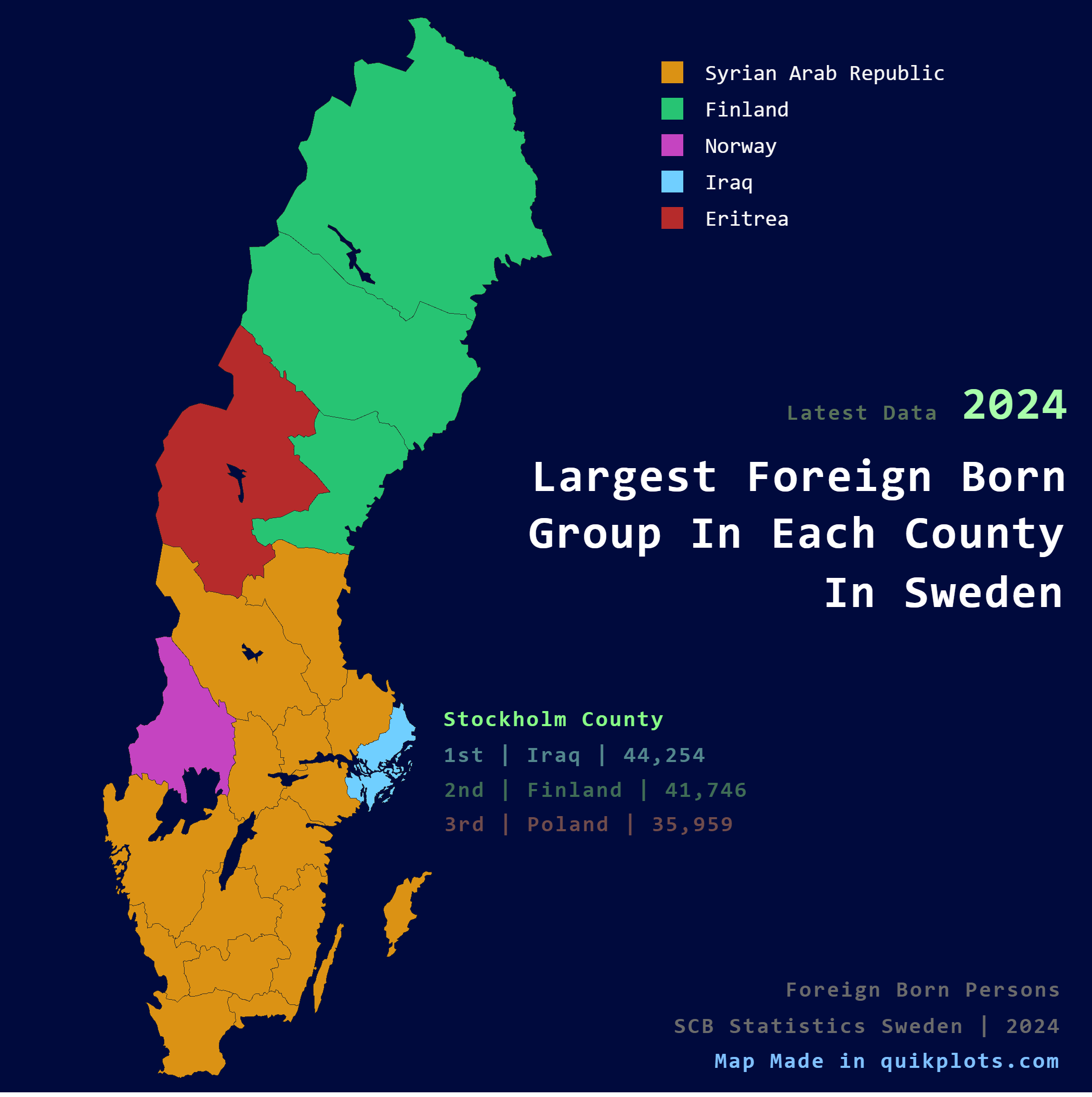Largest Foreign Born Group per County Map in Sweden


Marcus Rodriguez
Historical Geography Expert
Marcus Rodriguez specializes in historical cartography and geographic data analysis. With a background in both history and geography, he brings unique...
Geographic Analysis
What This Map Shows
The visualization titled "Largest Foreign Born Group per County in Sweden" presents a detailed breakdown of the predominant foreign-born populations across Sweden's counties for the year 2024. Each county on the map is color-coded to represent the largest ethnic group within its borders, providing a clear picture of Sweden's diverse demographic landscape. This map is based on the latest data from Statistics Sweden (SCB), which allows us to delve into the origins of the foreign-born residents who contribute to the rich tapestry of Swedish society.
Deep Dive into Foreign-Born Populations in Sweden
Foreign-born individuals play a crucial role in shaping the demographics of Sweden. As of 2024, Sweden is home to residents from approximately 185 different countries, reflecting a broad spectrum of cultural backgrounds. This diversity is not just a statistic; it enriches the social fabric of the nation, influencing everything from cuisine to economic contributions. Interestingly, foreign-born populations have been increasing steadily in Sweden, which presents both opportunities and challenges for integration and social cohesion.
The largest foreign-born group in Sweden comes from Syria, especially in counties like Stockholm and Örebro, reflecting the significant influx of refugees over recent years due to conflict and instability in their home country. Ever wondered why certain counties attract more immigrants from specific regions? It's often a combination of established communities, employment opportunities, and local policies that facilitate integration. Other notable groups include Iraqis, Poles, and Somalians, each contributing uniquely to their respective counties.
From an economic standpoint, foreign-born individuals have a significant impact on labor markets. They often fill essential roles in various sectors, including healthcare, construction, and technology. For example, the growing tech sector in cities like Gothenburg has attracted many foreign-born professionals, leading to a vibrant multicultural workforce. However, challenges remain, particularly regarding language barriers and recognition of foreign qualifications, which can affect employment prospects for many immigrants.
Regional Analysis
Breaking down the map, we can observe distinct regional trends. In Stockholm County, the Syrian population is the largest foreign group, reflecting the capital's role as a primary destination for newcomers. Conversely, in counties such as Skåne, we see a significant Polish presence, which can be traced back to historical migration patterns and proximity to Poland.
Interestingly, the distribution of foreign-born populations also correlates with urban versus rural settings. Urban areas tend to have a more diverse mix of nationalities, while rural counties may see a predominance of specific groups. For instance, in Västerbotten, the largest foreign group is from Finland, highlighting historical ties and geographical proximity. This regional analysis reveals how local economies and historical contexts influence migration patterns.
Significance and Impact
Understanding the largest foreign-born groups in each county is essential for grasping the broader implications of immigration in Sweden. This topic matters because it affects social policies, economic strategies, and community development initiatives. As Sweden continues to evolve as a multicultural society, addressing the needs of diverse populations will be crucial for maintaining social harmony and economic growth.
Current trends indicate that as global dynamics shift, Sweden may see further changes in its demographic makeup. For instance, the ongoing effects of climate change and international conflicts are likely to influence future migration flows. Policymakers must remain proactive in fostering inclusive environments that support integration and equality for all residents.
In conclusion, this map not only showcases the geographical distribution of foreign-born populations across Sweden but also serves as a lens through which we can examine the complexities of migration, integration, and cultural diversity. By understanding these dynamics, we can better appreciate the contributions of foreign-born residents to Sweden's identity and future.
Visualization Details
- Published
- October 3, 2025
- Views
- 18
Comments
Loading comments...